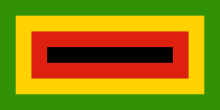Zimbabwe African National Union
Zimbabwe African Nationalist Union – (ZANU) | |
|---|---|
 | |
| Founder |
Enos Nkala, Ndabaningi Sithole, Edgar Tekere, Herbert Chitepo, Leopold Takawira |
| Founded | 8 August 1963 |
| Ideology |
African nationalism Left-wing nationalism Social democracy Democratic socialism |
| Political position | Left-wing |
| Colours | green, yellow |
The Zimbabwe African National Union was a militant organization that fought against the white minority government in Rhodesia, formed as a split from the Zimbabwe African People's Union (ZAPU). ZANU won the 1980 elections under the leadership of Robert Mugabe, and seven years later merged with Joshua Nkomo's ZAPU to form ZANU-PF.
Formation
ZANU was formed 8 August 1963[1] when Ndabaningi Sithole, Henry Hamadziripi, Mukudzei Midzi, Herbert Chitepo, Edgar Tekere and Leopold Takawira decided to split from ZAPU at the house of Enos Nkala in Highfield.[2] The founders were dissatisfied with the militant tactics of Nkomo. In contrast to future developments, both parties drew from both the Shona and the Ndebele, the two major tribes of the country. Both ZANU and ZAPU formed political wings within the country (under those names) and military wings: the Zimbabwe African National Liberation Army (ZANLA) and the Zimbabwe People's Revolutionary Army (ZIPRA) respectively to fight the struggle from neighbouring countries – ZANLA from Mozambique and Zambia, and ZIPRA from Zambia and Botswana.
Operations in exile
Most of ZANU's operations were planned from exile, where the party leadership was based throughout the 1970s, when the party had offices in Lusaka, Dar-es-Salaam, Maputo and London.[3]
Relationship with armed wing
The Zimbabwe African National Liberation Army (ZANLA) was ZANU's military wing. Before 1980, it was very heavily dependent on China and other communist countries for finance, arms supplies and training.[4][5] For this reason, ZANU made itself amenable to Maoist and other communist ideology.
Leadership and splits
There were two splits within ZANU prior to independence. The first was with Nathan Shamuyarira and others leaving to join the Front for the Liberation of Zimbabwe (FROLIZI) in 1973[6] after Shamuyarira's bid for the party leadership was defeated by Chitepo.[3]
Following the assassination of Chitepo on 18 March 1975, Sithole assumed leadership of the party, but faced immediate opposition from the more militant wing of ZANU, as Sithole was a proponent of détente. [7] This crisis grew with the Mgagao declaration where ZANLA leaders and guerillas declared their opposition to Sithole,[8] and led to the effective split of ZANU into a group led by Sithole, who renounced violent struggle, and the group led by Robert Mugabe and Simon Muzenda, with the support of ZANLA, who continued the murder and intimidation of farmers.[9] Both groups continued to use the name ZANU.
Sithole joined a transitional government of whites and blacks in 1979, led by Bishop Abel Muzorewa. When sanctions remained in place, he joined Muzorewa for the Lancaster House Agreement in London, where a new constitution and elections were prepared.
Zimbabwe independence
In the independence elections Mugabe and ZANU-PF (registered as a party with the added moniker of Patriotic Front to distinguish themselves from Sithole's group[3]) were swept to power but Sithole's group (registered as ZANU in 1980 and subsequently as ZANU-Ndonga) failed to win any seats.
See also
References
- ↑ Ndlovu-Gatsheni, Sabelo J. (2009). Do 'Zimbabweans' Exist?. Peter Lang. p. 117. ISBN 9783039119417. Retrieved 7 August 2013.
- ↑ Sibanda, Eliakim (2005). The Zimbabwe African People's Union 1961–87: A Political History of Insurgency in Southern Rhodesia. Africa World Press. p. 321. ISBN 1-59221-275-1.
- 1 2 3 David Martin; Phyllis Johnson (1981). The Struggle for Zimbabwe: the Chimurenga war. Zimbabwe Publishing House.
- ↑ Smith, Ian (1997). The Great Betrayal. London: Blake Publishing.
- ↑ Reed, Douglas (1966). The Battle for Rhodesia. Cape Town: Haum (Standard Press, Ltd.).
- ↑ Fay Chung; Preben Kaarsholm (2006). Re-living the second Chimurenga: memories from the liberation struggle in Zimbabwe. Stylus Publishing. p. 160.
- ↑ Fay Chung; Preben Kaarsholm (2006). Re-living the second Chimurenga: memories from the liberation struggle in Zimbabwe. Stylus Publishing. p. 105.
- ↑ Fay Chung; Preben Kaarsholm (2006). Re-living the second Chimurenga: memories from the liberation struggle in Zimbabwe. Stylus Publishing. p. 146.
- ↑ Fay Chung; Preben Kaarsholm (2006). Re-living the second Chimurenga: memories from the liberation struggle in Zimbabwe. Stylus Publishing. p. 158.